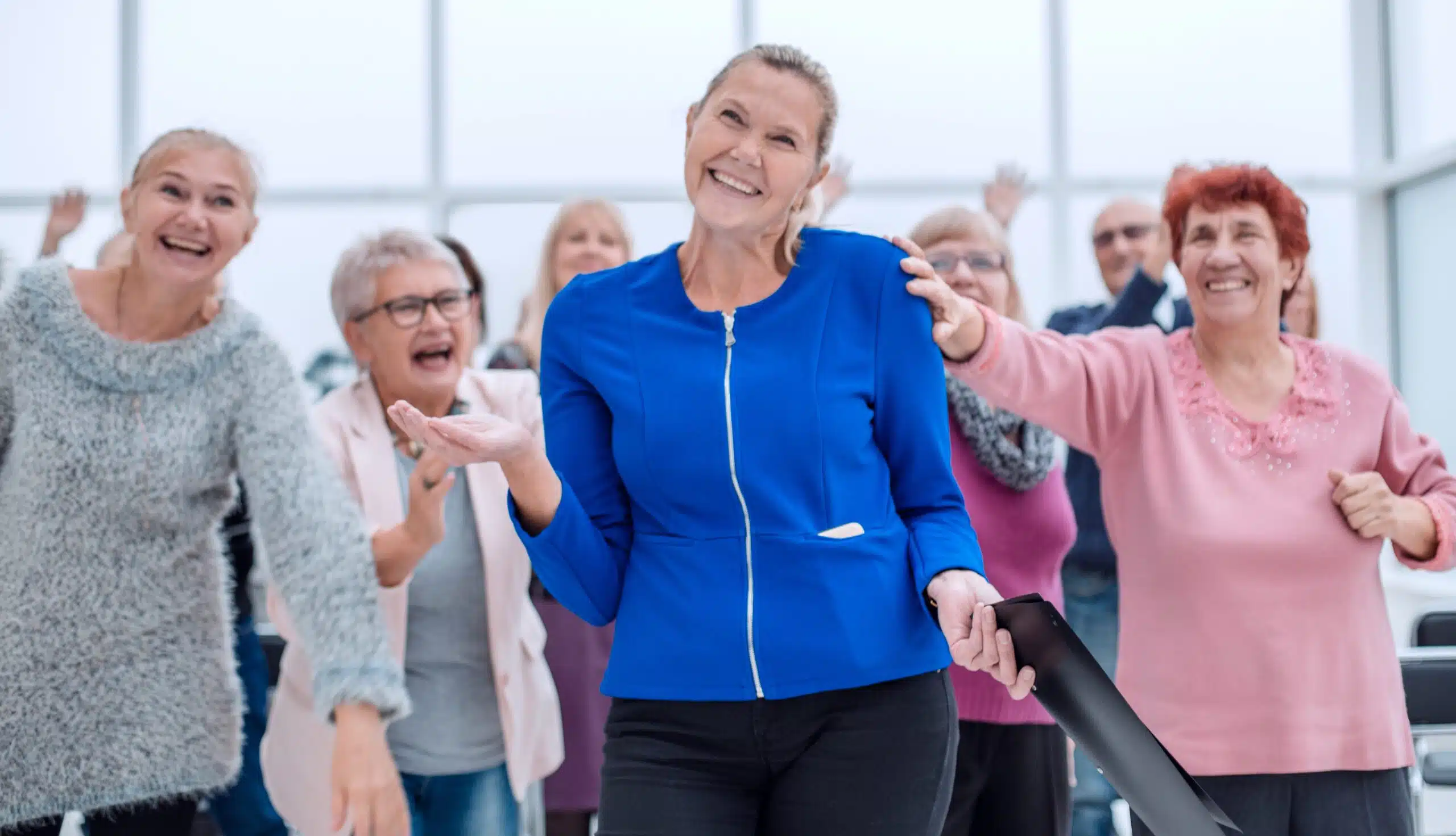Staying Healthy and Active After 50 as we age can often feel like an uphill battle. Studies show that our metabolism changes once we hit 50, making it even more important to maintain good nutritional habits and engage in regular physical activity.
This article is here to guide you through five easy ways you can thrive after 50 by adopting healthier routines, minimizing the risk factors of chronic illnesses and maximizing your enjoyment of life.
Get ready for a fountain of youth in words!
Key Takeaways
- Staying physically active after 50 is key to healthy aging, reducing the risk of heart disease, stroke, and memory problems.
- Adopting healthy eating habits, such as eating fatty fish and reducing sodium intake, can improve brain function and lower the risk of heart disease.
- Building strength through exercise and protecting your joints with low-impact activities like walking or biking can help prevent falls and injuries.
- Engaging in mental wellness activities, continuing to learn, socializing regularly, and prioritizing regular health check-ups are important for maintaining overall health and well-being.
Stay Healthy and Active After 50

Staying active after 50 is a key part of healthy aging. It lowers the risk of heart disease, stroke, and diabetes. Regular exercise can cut your risk of memory problems by half. Not only does it boost body health, but also helps keep your mind sharp.
A morning run or biking are great ways to stay fit. Low-impact activities protect your joints from damage. These exercises help with balance too so you do not fall easily as you age.
Moving around keeps high blood pressure at bay as well.
Bursts of physical activity throughout the day add up to big rewards for health too! Even if you’re busy, short breaks for a walk or stretch make a difference in how you feel Today’s tech makes it easy to track yourself using things like smartphone apps or fitness trackers.
But don’t forget – having fun should be part of any workout plan! Find something that excites you such as dancing, swimming or even gardening and stick with it.
Five Simple Ways to Stay Healthy and Active After 50

To stay healthy and active after 50, it is important to adopt healthy eating habits, keep physically active, engage in mental wellness activities, prioritize regular health check-ups, and encourage positive lifestyle changes.
Adopting Healthy Eating Habits
Eating right can make you feel great. It also helps you stay healthy. Cut red meat and butter from your meals. Eat more fatty fish instead, like salmon or mackerel. They are full of healthy fats that help the brain work better.
Eat flaxseed and nuts too. They have good fats as well. Try to cut down on how much salt you eat too, especially from ready-made food and snack packs. Leafy greens, fruits in bright colors, and low-fat dairy products should be part of your meals every day as it helps to boost energy levels when metabolism slows with age.
Incorporating Healthy Fats
Eating healthy fats is key to stay active and well. Foods like fatty fish, flaxseed, and nuts are a must eat. They have omega-3 fatty acids which help keep your heart strong. Avocados also give you good fats.
You can put slices on a salad or spread it on bread. Olive oil, too, helps as it adds flavor and health when you cook food or add it to salads. Your body will feel better with these healthier choices as they improve cholesterol levels and bring down swelling in the body.
Reducing Sodium Intake
Salt is in a lot of foods we eat. Too much salt is not good for the heart. You can cut down on salt to help your body. Get rid of premade and packaged meals that often have too much salt in them.
Start using low-sodium flavorings when you cook instead of adding more salt. This will help lower your blood pressure and cut chances of heart disease. It’s a simple step with big health benefits!
Making Smarter Food Choices
To stay healthy and active after 50, making smarter food choices is essential. Opting for nutrient-dense foods like dark leafy greens, colorful fruits and vegetables, lean meats, dairy products, and whole grains can provide the necessary vitamins and minerals needed for maintaining overall health.
It’s also important to limit high-calorie and high-fat foods while reducing salt intake to prevent conditions like high blood pressure and heart disease. By adopting a healthier diet, you can lower the risk of heart problems, cancer, and bone fractures in older age.
Keeping Physically Active
Staying physically active is crucial for maintaining good health and overall well-being, especially after the age of 50. Regular exercise can help reduce the risk of memory and thinking problems in older age by almost half.
It can also lower the risk of heart problems, cancer, and bone fractures, regardless of your age. To stay physically active, it’s important to protect your joints by choosing low-impact activities like walking or biking instead of running or high-impact exercises.
Building strength through aerobic exercise and strength training can also help keep your body strong and healthy. By staying active, you can improve your balance and prevent falls and serious injuries as you age.
Protecting Your Joints
Consuming fatty fish like salmon and incorporating healthy fats from plant sources like flaxseed and nuts can help protect your joints as you age. These foods contain omega-3 fatty acids, which have anti-inflammatory properties that can reduce joint pain and stiffness.
Building strength through regular exercise is also crucial for protecting your joints. Contrary to popular belief, running does not increase the risk of arthritis; in fact, it can strengthen the muscles around the knees that help support and protect them.
Additionally, staying active with low-impact activities such as walking or biking can also keep your joints strong and flexible. By taking these steps to protect your joints, you can maintain mobility and prevent joint damage as you age.
Building Strength
Building strength is an important part of staying healthy and active after 50. Regular strength training exercises can help protect your joints, increase muscle mass, and improve balance.
Strength training doesn’t have to involve heavy weights or complicated equipment – simple activities like lifting light dumbbells, using resistance bands, or practicing bodyweight exercises can be effective.
By building strength, you can reduce the risk of falls and injuries, maintain independence in daily tasks, and enhance overall physical function. So whether it’s doing push-ups against a wall or practicing squats with proper form, incorporating strength-building exercises into your routine is a great way to stay strong as you age.
Staying Balanced
Staying balanced is crucial for maintaining stability and avoiding falls as we age. Activities like tai chi can help improve balance and reduce the risk of injuries from falling. Regular exercise, including aerobic activities and strength training, also contributes to overall balance and stability.
Making sure our living spaces are free from hazards such as loose rugs or clutter can further enhance safety. By prioritizing balance exercises and creating a safe environment, older adults can stay active and independent for longer while reducing their risk of falls and related injuries.
Engaging in Mental Wellness Activities
Engaging in mental wellness activities is an important aspect of maintaining overall health and well-being, especially for individuals over the age of 50. By continuing to learn new things, such as playing a musical instrument or taking up a new hobby, you can promote mental stimulation and happiness.
Socializing regularly is also beneficial for mental health, whether it’s spending time with friends and family or joining community groups. These activities help combat feelings of loneliness and isolation, contributing to a greater sense of connectedness and fulfillment.
By prioritizing mental wellness activities, you can enhance your cognitive abilities, boost your mood, and improve your quality of life as you age.
Continuing to Learn
Learning doesn’t stop when we reach a certain age. In fact, engaging in new experiences and learning new things can contribute to our mental health and overall happiness. It helps improve concentration and memory, as well as build new pathways in our brain.
Research has shown that regular exercise in middle age can reduce the risk of memory and thinking problems in older age by almost half. So, let’s keep challenging ourselves and continue to learn throughout our lives to promote healthy aging and reduce the risk of various health issues like heart problems, cancer, and bone fractures at any age.
Socializing Regularly
Socializing regularly is important for individuals over 50 to maintain their mental and emotional well-being. It has been found that engaging in social activities can help reduce the risk of cognitive decline and dementia.
Socializing also provides opportunities for physical activity, such as walking or dancing, which contributes to overall health and fitness. Moreover, being socially active helps individuals feel a sense of purpose and connection, leading to a higher quality of life.
Additionally, social interactions enhance social skills and communication abilities, which are vital for maintaining relationships and support networks. So make it a point to spend time with friends, join clubs or organizations, or participate in community events – it’s not only enjoyable but good for your health too!
Prioritizing Regular Health Check-ups
Regular health check-ups are crucial for individuals over the age of 50 to keep track of their overall health. These check-ups help monitor important factors such as blood pressure and other vital numbers, ensuring that any potential issues are detected early on.
Staying up-to-date with vaccines is also important to protect against preventable illnesses. By prioritizing regular health check-ups, individuals can take proactive steps towards maintaining their well-being and catching any potential health problems before they become serious.
Additionally, medical expense accounts can provide financial assistance in covering the cost of these screenings and tests, making them more accessible for everyone. Taking care of your health through regular check-ups is a valuable investment in your long-term wellness and quality of life.
Tracking Blood Pressure and Other Vital Numbers
Tracking your blood pressure and other vital numbers is crucial for maintaining good health after the age of 50. Regularly monitoring these numbers can help you detect any abnormalities early on and take timely action.
By using wearable fitness trackers, smartphone apps, or home blood pressure monitors, you can easily track your overall health and progress over time. This not only helps in preventing various health conditions but also reduces the risk of serious problems like heart disease, diabetes, and stroke.
It’s important to consult with healthcare professionals who can provide personalized advice and guidance on maintaining and monitoring your health as you age.
Staying Up-to-date with Vaccines
Getting regular vaccines is crucial for maintaining good health and protecting yourself against preventable diseases. For adults over 50, flu vaccines and COVID-19 boosters are important to stay up-to-date with.
Flu vaccines help prevent seasonal influenza, which can be particularly harmful for older adults. COVID-19 boosters provide an additional layer of protection against the virus, especially as new variants emerge.
Additionally, it’s recommended that individuals over 50 get the shingles vaccine to prevent shingles, a painful condition caused by the reactivation of the chickenpox virus. Lastly, tetanus boosters should be given every 10 years to protect against this serious bacterial infection.
Encouraging Positive Lifestyle Changes
Making positive lifestyle changes is crucial for maintaining good health and well-being after the age of 50. By enjoying the benefits of aging, such as embracing new experiences and fostering contentment, we can find satisfaction and future happiness.
It’s important to prioritize sound sleep to combat insomnia, underlying problems like depression or anxiety, and ensure a healthier mental state. Additionally, rediscovering intimacy in our relationships can bring back enjoyment in life.
Taking small steps towards healthy habits like regular exercise and adopting a positive outlook can significantly improve our overall quality of life as we age.
Enjoying the Benefits of Age
As we age, there are many benefits that come with it. One of them is enjoying the rewards of age. With more experience and confidence, individuals over 50 can embrace a satisfying and content life.
Additionally, maintaining good physical health can contribute to future happiness. By adopting healthy habits such as eating nutritious foods and staying physically active, they can prevent diseases like high blood pressure, heart disease, diabetes, and cancer.
Taking care of their emotional well-being by managing stress and expressing their feelings also plays a role in healthy aging. Engaging in new experiences and challenging their minds through learning can greatly contribute to mental health and overall happiness as well.
Ensuring Sound Sleep
Getting enough quality sleep is essential for individuals over 50 to maintain their health and stay active. Lack of proper sleep can lead to various health issues and negatively impact overall well-being.
To promote better sleep, it’s important to establish a consistent sleep schedule and stick to it. This means going to bed and waking up at the same time every day, even on weekends.
Creating a comfortable sleep environment is also crucial. Keep your bedroom dark, quiet, and at a comfortable temperature to enhance sleep quality. Avoiding caffeine, nicotine, and alcohol close to bedtime can also help promote better sleep by reducing disruptions during the night.
Rediscovering Intimacy
Rediscovering intimacy is an important aspect of maintaining a healthy and active lifestyle after the age of 50. As people get older, increased confidence and experience can lead to improved sex lives.
To enhance intimacy, it’s crucial to focus on physical fitness, maintain a healthy diet, manage stress, stay socially engaged, and prioritize self-care. These habits contribute not only to better overall health but also create opportunities for deeper connections with partners.
By embracing these actions, individuals can experience the rewards that come with rediscovering intimacy in their lives.
The Rewards of Maintaining a Healthy Lifestyle After 50

Maintaining a healthy lifestyle after the age of 50 comes with numerous rewards. By staying active and eating well, you can significantly reduce the risk of heart problems, cancer, and bone fractures.
Engaging in regular exercise and making smarter food choices can have a positive impact on your overall health and well-being. It can also help lower blood pressure, improve cholesterol levels, and support weight management.
Additionally, staying mentally engaged through learning new things and socializing regularly can enhance cognitive function and contribute to emotional health. By taking care of yourself as you age, you can enjoy the rewards of better physical health, mental well-being, contentment, satisfaction, and future happiness.
Conclusion

In conclusion, staying healthy and active after 50 is achievable with simple lifestyle changes. By adopting healthy eating habits, keeping physically active, engaging in mental wellness activities,
prioritizing regular health check-ups, and encouraging positive lifestyle changes, individuals can enjoy the rewards of maintaining a healthy lifestyle.
These small steps can improve overall well-being and contribute to a happier and more fulfilling life after 50. Stay proactive and make your health a priority – it’s never too late to start!
FAQs
1. What are some tips to stay healthy and active after 50?
To stay healthy, you should cut sodium, limit salt intake, make smarter food choices avoiding high calorie and fat foods like premade and packaged foods. Building strength by setting small goals, getting enough sleep and taking care of your teeth also help.
2. How can I keep my mind sharp as I age?
Keeping your mind sharp is possible by always learning new things, challenging your mind and adopting a positive outlook on life.
3. Are there specific diet changes that can help improve health after 50?
Yes, improving diet involves cutting saturated fats to lower cholesterol, adding fortified foods rich in calcium for bones along with vitamin B12 and D supplements. A Mediterranean diet helps too.
4. Do social activities influence health after fifty years?
Yes! Social engagement through volunteering or making new friends can fend off feelings of emptiness from an empty nest or retirement while increasing life expectancy.
5. Can making healthier choices reduce risk of diseases after 50?
Making healthier choices reduces risks linked to heart attack, kidney disease, liver damage while slashing Alzheimer’s risk significantly.
6. How does expressing feelings impact health in older age?
Expressing your feelings openly helps manage stress effectively which reduces the chance of developing chronic conditions related to stress such as heart damage or lethargy.

